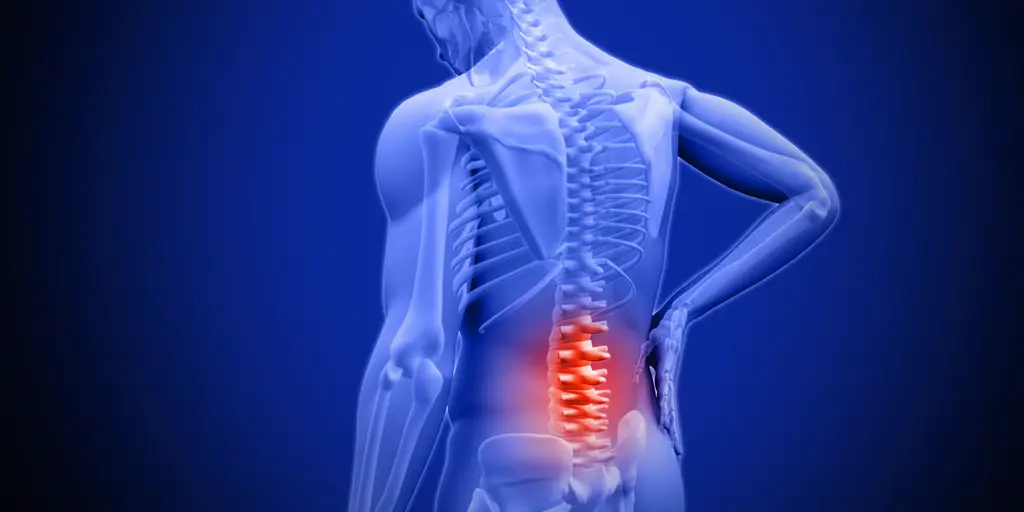THElumbar arthritis is a common condition among workers, especially those who perform tasks that strain the back, such as construction workers, drivers, orderlies, waiters, etc.
THElumbar arthritis can cause a Chronic Pain, a stiffness and reduced mobility, which can lead to disability and inability to work.
In order to better apprehend this pathology and its consequences on the professional life, the present article will approach generalities on this affection, but especially the disability rate for lumbar arthritis.
Introduction
La spine is divided into five sections: cervical, thoracic, lumbar, sacrum and coccyx. I'lumbar arthritis touches the lumbar part of the spine, or the lower back, which is located just above the pelvis.
THEosteoarthritis of the lumbar spine is very common, affecting approximately 30% of men and 28% of women aged 55-64 worldwide.
Although experts consider osteoarthritis a normal part of aging, the pain and stiffness of thelumbar arthritis can limit a person's ability to perform common tasks, especially those that require bending and stretching.
Causes and risk factors
It should be remembered that thelumbar arthritis is a type ofspecific arthritis. Indeed, the most common cause of the symptoms oflumbar arthritis is theOsteoarthritis, but other types are sometimes involved.
Here are some forms of arthritis that can affect the lumbar spine:
- Osteoarthrosis or osteoarthritis
- Spondyloarthritis
- Psoriatic arthritis
- osteoporosis
The main symptom oflumbar arthritis is pain in the lower back, which is called lumbago.
About 80% of back pain last less than a week. If it lasts much longer, doctors consider it a chronic back pain, and theOsteoarthritis may be the cause.
People withlumbar arthritis may feel pain in the center of the lower back. The pain may extend to the pelvic area or the sides of the buttocks. It can also extend to the thighs, but rarely to the knees.
Consequences of lumbar osteoarthritis in the workplace
THElumbar arthritis can cause a Chronic Pain, a Rhelper and reduced mobility, which can lead to disability and inability to work.
Very often, at the origin of a Osteoarthritis, we find a mechanical constraint, which can be exaggerated (overload) in the context of work.
This is the case of workers who perform fairly physical jobs, with the carrying of heavy loads, with exposure to mechanical vibrations transmitted by the seat, with regular flexion-extension movements of the trunk, etc.
Disability rate for lumbar osteoarthritis
THElumbar arthritis is a degenerative condition that can lead to partial or total disability in some cases.
Le disability rate for lumbar osteoarthritis may vary depending on the extent and severity of symptoms, as well as the impact of the condition on the ability to perform daily activities.
The evaluation of disability rate in case of lumbar osteoarthritis is usually performed by a physician specializing in physical medicine and rehabilitation.
This evaluation takes into account the patient's symptoms, functional limitations and medical history, as well as the results of clinical and radiological examinations.
Le disability rate is expressed as a percentage, ranging from 0% (no disability) to 100% (total disability).
Le disability rate for lumbar osteoarthritis depends on the patient's functional disability, which may include difficulty standing, limitation of mobility in the lumbar spine, pain and stiffness.
In some cases thelumbar arthritis can lead to permanent disability, requiring help and assistance with activities of daily living. In these cases, the disability rate may be high, but this will depend on each individual case.
It is important to note that the disability rate in lumbar osteoarthritis may vary depending on individual response to treatment. Treatments such as physical therapy, medications, and surgery can help improve symptoms and reduce the ifunctional disability.
In short
Le rate disability for lumbar osteoarthritis depends on the impact of the disease on the physical functions of the patient. It is important to consult a specialist physician for an accurate assessment and appropriate treatment to limit disability and improve quality of life.
L'disability can have significant economic and social consequences, not only for the worker, but also for his family and society as a whole.
It is therefore important to take preventive measures to reduce the incidence of lumbar osteoarthritis among workers, such as the promotion of healthy lifestyles, workplace ergonomics, occupational safety training, stress management and early medical management of symptoms.




